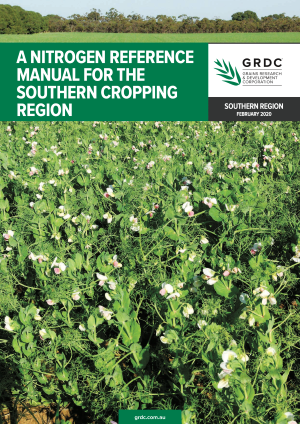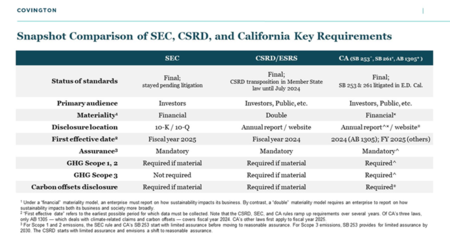
Key points
- In-season management of soil nitrogen can help growers capture crop yield potential.
- Nitrogen-poor soils in the southern growing region can compromise yields, especially in seasons with favourable conditions.
- A new GRDC publication summarises current knowledge and provides updated guidance on nitrogen management within farming systems.
- The Nitrogen Reference Manual includes information on nitrogen cycles in agriculture, nitrogen fixing by legume crops; estimating nitrogen supplies from soils, crop yield potential and nitrogen demand; optimising economic and seasonal risks; and grower nitrogen strategy case studies.
Nitrogen resource helps close yield gap
Growers can better capture the yield potential of their cereal and canola crops by carefully managing nitrogen supplies.
Applying nitrogen fertiliser in-season based on available moisture and predicted yields helps ensure the nutrient demands of the crop can be fully met, while minimising the economic and seasonal risks of extra inputs, especially in wet conditions.
To support growers and advisers in understanding soil nitrogen cycles and requirements in agriculture, the GRDC has published A Nitrogen Reference Manual For The Southern Cropping Region.
The manual is a comprehensive guide to understanding, managing and estimating N requirements from paddock to paddock and season to season and is available on the GRDC website.

Signs of nitrogen deficiency
The updated Nitrogen Reference Manual was collated by a team from the University of Adelaide, University of New England, the University of Melbourne and farm advisers, as part of a GRDC-invested project.
Project leader, Associate Professor Matthew Denton from the University of Adelaide, says it is important for growers to make proactive assessments of soil moisture and crop yield potential during the growing season and add nitrogen if it is needed – particularly after favourable growing conditions.
“Adjusting in-season inputs to the estimated yield potential helps minimise seasonal and economic risks,” he says.
In medium and high rainfall zones of southern Australia, application of some of the fertiliser nitrogen can be delayed until the season is well under way, once the crop’s yield potential and nitrogen requirements are more certain, rather than trying to estimate these before or at sowing.
Signs of nitrogen deficiency in cereals include lower older leaves that turn pale and senesce early, low tiller numbers, and grain protein below 10 per cent in rainfed cereals. However, these are easily confounded with other issues, such as waterlogged conditions.
“Waiting for visual signs of nitrogen deficiency is not recommended because by the time these symptoms are evident, crop yield potential has already been compromised,” Assoc. Professor Denton says.
“Monitoring soil nitrogen reserves, soil moisture and crop yield potential, along with careful management of nitrogen inputs are vital for crop productivity and ongoing profitability.”
In-season actions
While there are useful rules of thumb that can help growers with in-season nitrogen decisions, nitrogen budgeting approaches that take into account nitrogen supply from fertiliser, soil mineral nitrogen and the likely mineralisation of nitrogen from soil organic matter are needed for more accurate management.
The Nitrogen Reference Manual outlines the key nitrogen fertiliser decision points for cereal crops:
Pre-sowing: Collect soil samples to depth and analyse for available nitrogen.
Sowing: Apply sufficient nitrogen for a modest yield potential or, if there is very good stored soil moisture at sowing, a higher yield potential.
Tillering: Reassess soil moisture, check tiller numbers in relation to current estimates of yield potential and apply nitrogen to increase tillers if required.
Stem elongation: Reassess soil moisture, tiller number and yield potential based on seasonal rainfall and outlook. If required, apply fertiliser nitrogen to match yield potential and the grain protein target.
Booting: If yield potential has increased significantly (e.g., due to favourable conditions in winter and early spring), additional nitrogen fertiliser may be needed to maintain desirable protein levels.
Harvest: Assess grain protein levels and nitrogen removed from the paddock. Assess the likely extent of unused fertiliser nitrogen in the soil and review the fertiliser strategy against its final outcomes to plan the next season’s nitrogen strategy.

Nitrogen decision tools
The mineralisation of soil organic matter is an important process providing nitrogen to crops. It is influenced by a number of soil, weather and crop management factors.
A Nitrogen Reference Manual For The Southern Cropping Region includes a preliminary assessment of tools for estimating nitrogen mineralisation during crop growth in the southern cropping region.
The manual alsoincludes information about the various nitrogen decision aids available to growers and advisers across the country.
The manual dedicates a chapter to how legumes fix nitrogen from the atmosphere, which becomes available to following crops through the mineralisation of legume residues, and ways to assess the efficiency of these processes.
It also offers detailed information and analysis of the economic considerations for investments in nitrogen fertiliser.
Additional chapters provide the current knowledge and useful references for details on:
- Nitrogen cycling in agricultural systems
- How plants take up and assimilate nitrogen, and how that affects grain yield and protein concentration
- Soil nitrogen levels across different crop rotations and farming systems
- Selecting and applying fertiliser nitrogen
Case studies illustrate nitrogen management strategies used by five grain growers in South Australia and Victoria to optimise yields and grain protein levels.
Free download
GRDC Manager Soils and Nutrition – South, Stephen Loss, says the comprehensive manual is a valuable resource for advisers, fertiliser representatives, agribusinesses and growers.
“Many of the southern region’s soils are experiencing decreases in organic matter contents, and hence, growers are having to rely more heavily on fertiliser nitrogen inputs,” he says.
“The new manual will help improve fertiliser and legume nitrogen management across crop rotations so growers can optimise profits while protecting soil fertility and the farm resource base.
“The manual is more than 100 pages long, so no one is going to read it in one sitting. However, we hope growers and advisers will refer to a chapter or section whenever they have a specific question.”
A Nitrogen Reference Manual For The Southern Cropping Region is available from the GRDC website.
A new GRDC video, ‘new thinking on when to apply nitrogen to your wheat crop‘, is available for viewing.








